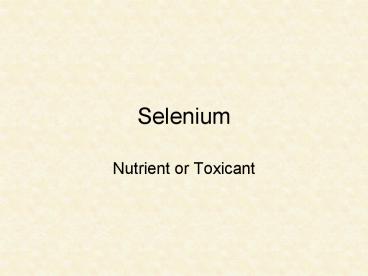Selenium - PowerPoint PPT Presentation
1 / 10
Title:
Selenium
Description:
Selenium Nutrient or Toxicant Chemistry of selenium Group VIB metalloid Commonly occurs with and replaces sulfur Four oxidation states: -2, H2Se: toxic and reactive ... – PowerPoint PPT presentation
Number of Views:102
Avg rating:3.0/5.0
Title: Selenium
1
Selenium
- Nutrient or Toxicant
2
Periodic Table of the Elements
3
Chemistry of selenium
- Group VIB metalloid
- Commonly occurs with and replaces sulfur
- Four oxidation states
- -2, H2Se toxic and reactive gas
- 0 elemental selenium red amorphous or black
crystalline solid insoluble and unreactive - 4 selenite (SeO32-) Soluble and toxic but
easily reduced to elemental Se - 6 selenate (SeO42-) Most soluble and toxic, and
easily taken up by plants
4
Occurrence of Se
- Crustal abundance 0.05 ppm
- Se substitutes for S in pyrite, chalcopyrite, and
bornite in copper and copper-lead-zinc sulfide
deposits - In rare Se minerals crooksite (Cu7(Tl,Ag)Se4) and
clausthalite (PbSe). - In sedimentary uranium and phosphatic deposits
- In siltstones and shales.
- In volcanic gases
- Concentration ranges from 0.1 to 1200ppm.
- Few deposits contain high enough concentrations
of selenium for economic mining. - Se obtained from the refining of anode slimes,
from electro-winning of copper. - Or from the leaching of flue dusts from sulfide
ore smelters - Annual production of selenium over 2100 metric
tons.
Black botryoidal clausthalite
5
Uses of Se
- Glass manufacturing, electronics, agriculture,
metal alloy production, and in chemical and
pigment production. - Agricultural/biological applications (e.g., as an
additive to animal feeds and fertilizers). - Demand for selenium may increase in the future
due to the possibility of using selenium to
replace lead in plumbing brass and other lead
alloys. - Canada is among the world's largest producers
6
Nutrient
- O.04 ppm Se essential
- 0.04 - 0.1 ppm Se beneficial
- 3 ppm toxic
- Se deficiency causes muscular degeneration,
impeded growth, fertility problems, anaemia,
liver disease - Selenium is a micronutrient required by fish,
birds, and mammals (including humans) to maintain
good health - Plants will uptake selenium and make it available
to foraging animals, but no nutritional
requirement has been found for selenium in
plants. - Animals require approximately 0.1 mg/kg Se to
maintain levels of the enzyme glutathione
peroxidase (SeGSHpx), which assists in the
conversion of free radicals into other harmless
products. - Deficiencies in selenium
- can inhibit growth,
- limit reproductive capability,
- reduce appetite,
- possibly lead to death.
7
EC Guidlines
- The Canadian Soil Quality Guideline (CSoQG) for
Se - in agricultural and residential/park lands is 1.0
mg Se /kg of soil. - on commercial and industrial lands is 3.9 mg
Se/kg of soil. - US EPA
- Maximum contaminant level (MCL) for drinking
water is 10 µg/L and 5 µg/L for chronic exposure
for aquatic life. - Waters containing more than 1000 µg/L are
considered toxic waste by the EPA.
8
Toxicant
- Small margin of safety between levels of Se
compounds that will cause dietary deficiency and
those that result in toxicity. - 3-15 mg Se/kg food can cause chronic or acute
selenosis and death. - Many symptoms of Se toxicity are similar to those
observed in cases of Se deficiency. - In general, very high levels of dietary Se
produces dizziness, fatigue, irritation,
collection of fluid in the lungs, and severe
bronchitis, stillbirths, and malformation of
offspring. - Se compounds on the skin cause rashes, swelling,
and pain. - High blood levels of Se can also result in
selenosis, - symptoms are garlic odour breath, thickened and
brittle nails, hair and nail loss,
gastro-intestinal problems reduced hemoglobin,
mottled teeth, skin lesions, and pain or numbness
in the limbs. - Selenite is 100 bioavailable.
- In 1987, the USA EPA designated selenium as a
priority pollutant based on the narrow range
between beneficial and toxic concentrations, - Toxic effects of Se found in bacteria, fungi,
algae, plants, and invertebrates.
9
Locoweed
- Cattle eating plants rich in selenium
(loco-weeds) get the "blind staggers" muscular
dystrophy appear drugged. e.g. in San Joaquin
Valley in California - Locoweed is a species of poisonous plants of the
genera Astragalus and Oxytropis, in the pea
family (Fabaceae), native to the prairies of
north central and western North America. - Locoweed is eaten during the early spring and
late fall, when it is often the only green plant
available to grazing animals. - Ingestion causes symptoms similar to BSE,
including erratic behavior, aggression, lethargy,
depression, loss of balance, nervousness, and
abortion, among others. - Although symptoms reduce with time after removing
the animal from exposure to locoweed, some nerve
damage is permanent. In horses, Horses are
especially susceptible to selenosis and have
necrotic hoof and brain damage can make them
dangerous to ride.
10
Mining Issues
- Selenium behaves in a similar way to S oxidation,
producing selenite (SeO32-) and selenate (SeO42-)
anions. - Kinetically favored selenate is the most common
in oxidized waters, but neutral to acidic
environments will favor the selenite and
biselenite forms. - Selenate is much more mobile in an aqueous
environment and is much harder to treat than
selenite.































